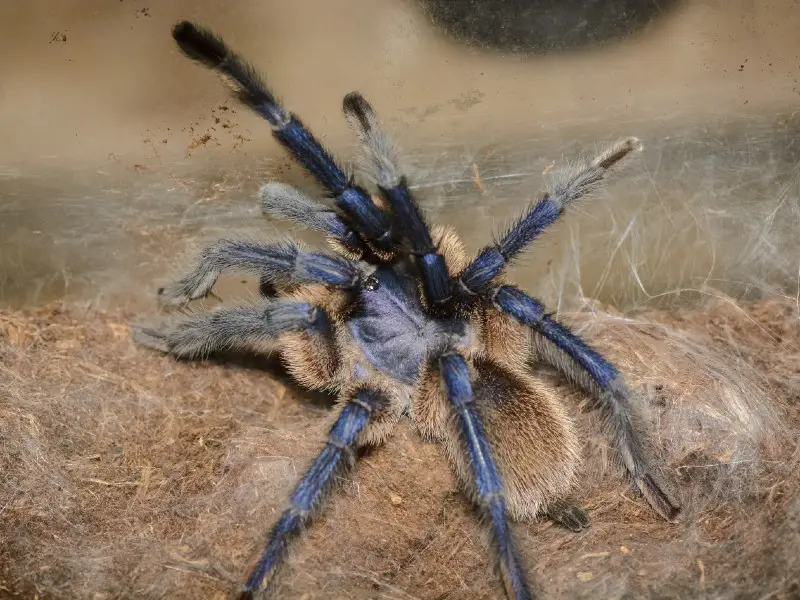
Having a tarantula is not something for the faint hearted. It isn’t a pet that will be cuddly or make for a stunning visual display. A Cobalt Blue Tarantula should only go to the home of someone who’s a professional hobbyist or an award-winning entomologist.
If you’re new to the hobby and you’re looking to get your first tarantula, it may be better to go with another species once you read the care guide below. They have a particular diet and must have the proper habitat in order to thrive. Plus, it won’t often be that you see them since they prefer the dark coziness of their burrows.
Regardless, they can be interesting pets to have. Their habits, modes of being and mannerisms are fascinating to observe. But they really are for more advanced pet keepers who are capable and responsible enough to ensure these spiders get what they need.
Cobalt Blue Tarantula Overview
Cobalt Blue Tarantulas have their name from the color on their legs. Their bodies and carapaces are dull in comparison, giving off a grayish blue hue. But this blue is only visible under bright light, otherwise they look black or very dark gray. When you can see the blue, they have a shimmery metallic quality reflected off the hairs. Some hairs can even appear white or yellow in color.
Care Guide
Native to Myanmar, they also come from Thailand, Vietnam, Laos, Cambodia and even Singapore. They live in tropical forests by creating deep burrows in the earth. These tarantulas only leave their lairs when it’s time to scavenge for food.
So, if you want to have one as a pet you have to mimic their native conditions. It must be warm and humid with plenty of substrate for burrowing. Cobalt Blue Tarantulas are medium in size and grow at a very rapid pace; molting about every four to six months. Once spiderlings reach sexual maturity, the gender becomes clear. Females stay blue and males develop a blue-gray.
Diet and Feeding
The only time a Cobalt Tarantula leaves its burrow is when it’s time to eat, and these spiders are impressive predators. They move quickly and catch prey at the outermost edges of their burrow. Once they inject their venomous poison, they drag it back to their lair and eat it alive.
Types of Food
Cobalt Blues will eat amphibians, insects like cockroaches and crickets, mice, and other spiders. Some qualify their eating habits as “greedy” because they require plenty of fuel to support how fast they grow. Whatever they eat, it isn’t bigger than their carapace and their food must be alive and fresh, not frozen or dead. They can eat up to five large crickets per week.
Don’t feed your tarantula cockroaches or crickets you find in your yard. Source them from a pet food supplier to ensure they are free of parasites and mites. However, if a bug finds its way into your spider’s cage, there’s not much you can do if it’s already feasting on it. Just ensure you discard any leftovers.
Lifespan; Health Concerns
In captivity, female Cobalt Blue Tarantulas can live between 20 and 25 years old. The males have a shorter lifespan, ranging from five years to no more than 10 years old. In the wild, they can live up to 30 or 20 years old, respectively.
The most common health concern for these arachnids is staying hydrated in captivity. They often succumb to dehydration. So, water, humidity, and a moist substrate are imperative.
Also, if you don’t clean the tank at least once a month, bacterial issues can build up in the substrate from uneaten food. Sometimes, if leftovers lie around too long, parasites and mites can infect the tarantula. Other than that, they don’t usually suffer from diseases or other disorders.
Behavior
Cobalt Blue Tarantulas spend most of their time in a burrow. At night, they’ll come out to eat or build a spider web. They’re often quite docile, but they can be very defensive and what humans classify as “touchy.”
Cobalt Blue Tarantulas aren’t afraid to attack anyone or anything when they feel threatened. Also, they have a pretty powerful bite that deposits a small amount of venom into its victim. Otherwise, they’re fairly calm, docile, and chill. They don’t need a lot of exploratory room or other fancy toys to stay engaged.
Molting
When they begin molting or shedding skin, they’ll stop eating. They’ll roll onto their back on the substrate, and it looks as if they’re dying. Don’t worry if you witness such a thing; this is normal. It takes about 15 minutes to several hours to remove their exoskeleton. Don’t touch or bother the spider during this process as it could mean their ultimate demise.
Mating Habits
When a male is ready to breed, he creates a small silk sack from which to deposit his sperm. He then stores this in his pedipalps and then locates a female to invite for mating. If she’s receptive, then a dangerous and life-threatening mating ritual ensues.
The Male’s Role; Possible Fate
The male attempts to deposit this sperm sac into the female’s pedipalps by pinning down her pincers and legs so she can’t fight back. If he is successful, he has a few minutes to get away because the fertilization process has chemicals that intoxicate the female.
In the event that the male doesn’t get away, isn’t successful, isn’t careful enough, or if she doesn’t find him a suitable mate, he quickly becomes dinner for the female Cobalt Blue Tarantula.
The Role of the Female
Upon successful fertilization, females lay as few as 100 eggs or as many as 1000. These take about 45 days to two months to hatch. The mother stays with the egg sac on the web prepared especially for the expectant young. The spiderlings stay with their mom for about a week before striking out into the world on their own.
How to Keep the Cobalt Blue Tarantula Safe
The best way to keep a Cobalt Blue Tarantula safe is by first ensuring you understand this animal inside and out before acquiring one as a pet. Learn everything you can about its habits in the wild and in captivity. Then you want to ensure you source your arachnid from a reputable breeder. Do not obtain one freshly caught from the wild.
Then, make sure you have a large enough glass tank with a secure lid, ensuring the tarantula’s environment is to its liking. Keep other pets, large or small, away from your tarantula.
Understand this is not the kind of pet you’ll be able to carry around on your shoulder or interact with. Sure, you’ll be able to handle it if it’s amenable to the idea, but you should never force it.
Does the Cobalt Blue Tarantula Pose a Threat to Humans?
Due to the natural defensiveness of Cobalt Blues, they will attack if they feel threatened. The good news is that there are no known reports of people dying or suffering from a severe injury after receiving a bite from this arachnid.
Venom Isn’t Threatening
The level of toxicity in the venom can take down and stun potential prey, but it doesn’t pose an immediate threat to humans. That said, if someone is allergic to the venom, they should seek medical attention right away.
The Bite of a Tarantula
A tarantula bite feels something like a bee sting. It hurts with swelling and itching at the bite site. The good thing about Cobalt Blue Tarantulas is that they don’t have hairs they scrape off of their abdomen, like ones from North America do. They just have the bite, so it makes them a safer pet than other species in some ways.
Signs of an Imminent Attack
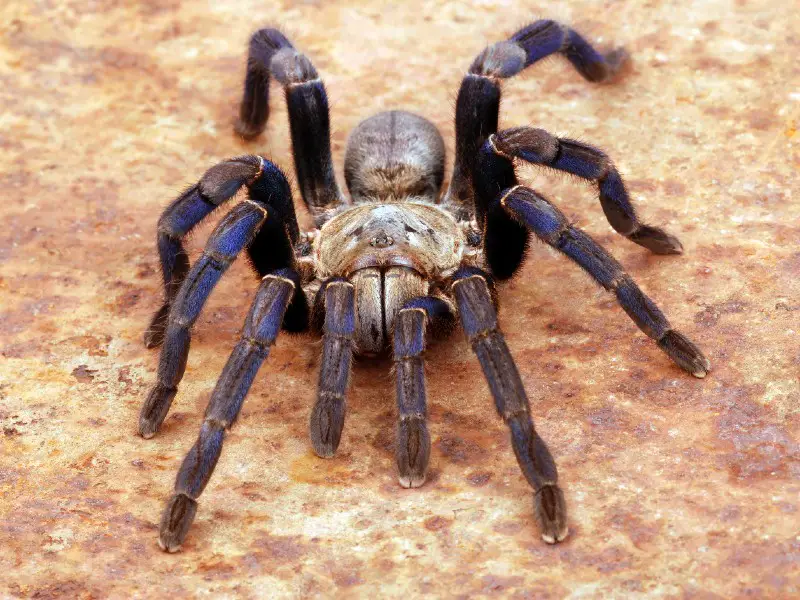
You’ll know a Cobalt Blue Tarantula is about to attack when they stomp the ground and raise their legs. This is a warning to back off. They will also show their fangs by rolling them back or extending them forward.
Sometimes there won’t be any warning, they’ll just bite out of nowhere. So, they don’t need provocation to have a reason for attacking. This is because they’re wild animals and they act on instinct. There is no way to anticipate this either.
Observe Safety
When you have to put your hand in the cage or handle the tarantula in any way, it’s imperative you have a nice pair of thick gloves. Keep your arms covered and don’t let the spider anywhere near your face.
Average Cost and Where to Buy Cobalt Blue Tarantulas
You can find Cobalt Blue Tarantulas at pet stores but it’s highly advisable to obtain one from a reputable breeder. This way you will ensure the health and well-being of the arachnid.
To get a Cobalt Blue Tarantula, it costs between $50 and $100. But there are other things to take into the budget. Consider the following:
- 10 to 20 gallon terrarium/tank – $25 to $50
- Substrate/Dirt – $5 to $10
- Heat Lamp/Pad – $10 to $15
- Water Dish – $5
- Food – $5 to $10 per week
- Pet Insurance – about $300 per month (depending on the carrier and completely optional)
In all, you’re looking at about $135 for an initial investment with around $40 per month for food and substrate. Keep in mind that you probably won’t need a heat lamp or pad. The temperature within the cage should remain between 75°F and 85°F. However, if the temperature varies greatly in wintertime, then using a heating lamp or pad will be necessary.
Facts and Useful Information
The following are tips, facts, and useful information you can take into account when caring for a Cobalt Blue Tarantula:
- Although Cobalt Blue Tarantulas don’t get much larger than five to nine inches, they need plenty of room. This is important for creating their burrow and building a web for catching food.
- When you put substrate into the tank, ensure it’s a blend of cork, coconut coir, soil, and moss. A good blend of various items recreates their native habitat. Give them at least eight inches or more of the substrate so they can create their lair.
- Tarantulas are not always allowed as pets in some areas. Make sure you check with local and state laws before owning one.
- Even if tarantulas are okay to have as pets, some municipalities forbid breeding them or have other captivity restrictions. So, it’s equally important to finding out what’s allowed in your area prior to purchasing.
- Cobalt Blue Tarantulas are excellent escape artists. Make sure they don’t get loose in the house by keeping a lid tightly secured on the tank.
- Ensure the arachnid’s enclosure has plenty of ventilation and humidity; this will help keep the Cobalt Blue comfortable and thriving. Humidity should range between 70% and 80%. It may be necessary to keep a humidifier near the cage to help keep things moist. Also, spray the substrate with water.
- Don’t allow uneaten food to rot in their cage. Take it out the moment you see it to prevent disease. Likewise, keeping their tank clean will prevent the tarantula from getting sick.
|
Species Facts |
|
|
Common Name |
Cobalt blue tarantula |
|
Species Name |
Cyriopagopus lividum |
|
Family Name |
Tarantulas |
|
Price |
Between $90 to $150 |
|
Size |
13 cm leg span |
|
Lifespan |
Up to 15 years |
|
Diet |
Large insects |
|
Tank Size |
10 to 20-gallon tank |
|
Humidity and Temperature |
Humidity between 70 and 80% with temperatures of 78 and 84 degrees Fahrenheit |
|
Popular Alternatives |
Most tarantula species |
Summary
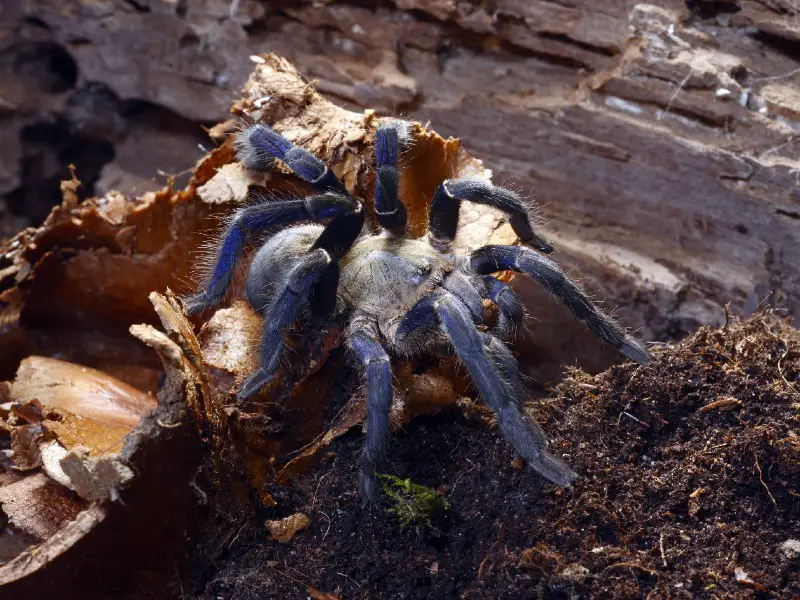
Cobalt Blue Tarantulas can be a cool-looking pet to have. But it’s important to understand that these aren’t the cuddly type that you can handle with any amount of frequency. This is only a pet for advanced and more experienced people familiar with tarantulas.
So, those who are new to the hobby must inform themselves thoroughly before undertaking such a pet. They must have the right kind and amount of substrate to create a proper burrow. Plus, the tarantula must remain humid while keeping the tank bacteria-free. This includes fresh, clean water every day.
Also, Cobalt Blue Tarantulas must have as much fresh, live food as possible. Their instincts will not accept frozen or dead offerings. You have to remove leftovers, refuse, and any other uneaten food to prevent bacteria and diseases from building up in the terrarium.
Sources:
- https://en.wikipedia.org/wiki/Cobalt_blue_tarantula
- https://www.nationalgeographic.com/animals/article/151127-blue-tarantula-science-explain-animals

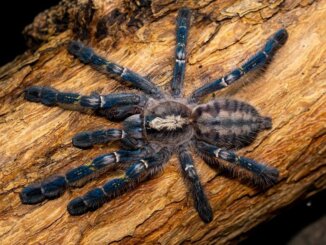

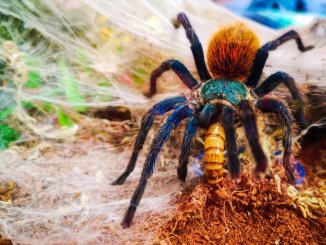

I’ve owned a Colbalt Blue tarantula now for around four years, She is a beauty, doesn’t
seem to be very aggressive, or want to escape. But this year she seems to have recently gone to
the bottom of tank sealed the entrance hole, she seems to be hybernating, This hasn’t
been done before that I noticed.Do they usually hybernate. Let me say I never try to
touch, or have my fingers close to her.
That is quite a sight!
Tarantulas can indeed go into a dormant state, but this rarely happens in captivity. Even more peculiar is that you have a tropical species which should not experience cold winter months so we are not aware of this behavior in the Cobal Blue. But we might be wrong!
Has she experienced colder temperatures before hiding in her hole? Did you have issues feeding her?
Tarantulas don’t hibernate. This is normal behavior, several of my species do this to molt. one of my Cobalts did this for almost 2 months, I was a little concerned but didn’t want to destroy the borrow. Then one day the tunnel was open and there she was a great deal larger than before. just make sure to pour some water on the substrate to keep it wet underneath. I believe they seal the entrance so as not to be bothered by crickets,roaches etc. Hope this helps